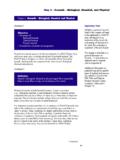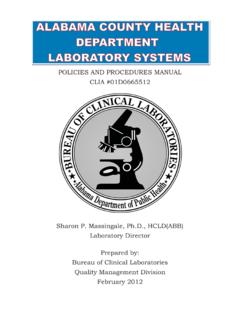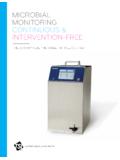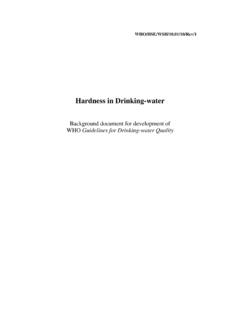Transcription of The Seven Practices of Successful Almond Growers
1 The Seven Practices of Successful Almond Growers 1: Documentation Maintaining readily retrievable records of all Almond farm operations is essential and beneficial when it comes to food safety. Although there are many common elements, each farm operation is unique. Specific documentation and record keeping down to the orchard are optimal to maximize YOUR investment in risk reduction. There are no off-the-shelf GAP programs but resources are available to get you started with a written plan and key documentation development. Remember don t be intimidated into inaction- your GAP program can evolve in phases, working toward the point where adequate records include (but not limited to): Detail of prior farm history and ownership. Detailed diagram of facility and orchard layout.
2 Detailed flow-chart or spreadsheet for variety mix and harvest sequence. Detailed diagram of adjacent land use, operations, and influences. Crop management flow chart (pre-bloom to post-harvest). Worker training programs and evidence of training. Placement and servicing of sanitary facilities. Invoice records for sanitation and personal hygiene supplies. Water source information, water testing plan and results. All pesticide and foliar application information. All fertility management operations. Detailed orchard floor management program. Resources to Get Started GAP resources can be found at in the Food Quality and Safety section. Also available in hard-copy form by request to: The Almond Board of California Good Agricultural Practices Manual 1150 Ninth Street Suite 1500 Modesto, CA 95354 Additional information and access to GAP planning resources are available from the University of California, Davis at and 2.
3 Employee Training Informed and trained employees are key assets to your business and are a critical component in effectively executing your GAP program. Preparing for effective awareness and skills training begins with a written employee-training program. Implementing and documenting training sessions are crucial to the success of your food safety risk reduction program. Written procedures for equipment operation, with food safety in mind, can be simple to get started but should be comprehensive to include all machines and devices used in crop management and handling high quality, safe almonds. Written procedures should be available to ensure all individuals who take part in year-round or seasonal orchard management receive training in your expectations and their responsibilities in personal hygiene on the farm.
4 Employee training should include: Regularly scheduled training and reinforcement sessions. Documentation of employees trained at each session. Specific training in proper use of portable toilet and hand wash facilities. Specific training in thorough hand washing techniques. Clear understanding of management policy and expectations for reporting illness and injury. Management policies and procedures to prevent ill or injured workers from contacting almonds. Cleaning and sanitation sequence for all equipment and tools used in the management of orchards. Resources for Employee Training Visit the Food Safety section for additional online resources. Farm and ranch worker friendly videos, in English and Spanish, are available from the National GAPs Program at These short VHS or DVD training tools made for fruit and vegetable producers and harvest operations were filmed extensively in California.
5 They are an easy, informative and uniform way to introduce your employees to critical aspects and needs of personal hygiene on the farm. Though not specific to almonds, the shared responsibility for food safety to protect your business and employees source of employment is evident. 3: Fertilizer and Soil Amendment Practices The improper handling and use of animal waste (manure, bedding and litter, biosolids, liquid effluent) for soil fertility management, or as part of animal waste disposal by land application, is a clear business risk for Almond Growers . The Almond Board of California does not support the use of manure as fertilizer, but if used, the manure must be applied properly. The intimate and extended contact harvested almonds have with the orchard floor demands that all practical steps to minimize the intentional introduction and survival of human pathogens in soil must be taken.
6 Recent Almond -associated outbreaks of Salmonella and detection of Salmonella in several orchard floor surveys has elevated the level of concern for raw almonds. Carefully controlled research studies have demonstrated the potential for the Almond kernel to be at risk of contamination during windrowing and sweeping. Using non-composted manure (mixtures of feces, urine, and other organic matter) increases microbial risks on the farm and could contribute to food borne illness. Stacked and aged manure is not the equivalent of well-managed compost and is known to have a greater potential to harbor surviving pathogens. Although food safety recommendations generally specify a preharvest interval of at least 60 days between manure application and harvest, there is a lot of uncertainty about the survival potential of pathogens in soil.
7 Some GAP guidelines and certification bodies require a minimum of 120 days preharvest interval. Research has demonstrated survival of pathogens from manure incorporation, under certain conditions, exceeding 200 days. Recent studies show that under the right conditions pathogens may survive for several years in an orchard. With this degree of uncertainty, Growers are faced with difficult management decisions. If manure application is an integral part of your orchard management, the following steps are highly recommended. Manure should not be applied to Almond orchards during the growing season. Store manure away from areas where almonds are grown and handled. If under your control, measure the temperature of stacked manure to ensure it reaches 131-140oF for at least three days at a depth of 18-24 inches.
8 Adding fresh manure to an aged-stacked pile is not a good practice; re-contamination and growth on residual nutrients is likely to occur. Erect physical barriers and/or diversion buffers to prevent run-off from the stacked piles into water sources, equipment storage areas, orchard traffic areas, or into the orchard. Consider using tarps or other barriers to minimize wind-driven drift of particles from manure piles and windrows. Although the outer surfaces of manure piles tend to be dry and have the lowest microbial numbers these are also the areas that are typically exposed to non-lethal temperatures during aging. Wind-driven transfer of pathogen indicators from field-side manure piles to adjacent crops has been demonstrated. It is highly recommended that manure be fully incorporated into the soil.
9 Pathogen die-off is accelerated by incorporation as compared to broadcasting to the soil surface alone. If incorporation is not possible or practical under your management plan, it is strongly advised to use only adequately composted materials to maximize pathogen elimination. Maintain records of suppliers and hauler/spreaders of manure and compost and dates of delivery as well as dates of broadcast or, preferably, incorporation. If purchasing compost from a certified supplier, obtain and keep a Certificate of Analysis for documentation. Thoroughly clean tractors, front-end loaders, and other tools and equipment used in manure handling after each use. Prevent wash water from draining to water sources, the orchard floor, or any area where harvested almonds are handled or stored.
10 Access to Regulations and Standards for Manure and Compost To get started on GAP specifics for soil amendments go to Food Quality and Safety at Standards for composting are regulated by the California Integrated Waste Management Board (Title 14, California Code of Regulations, Section ) at Resources for industry standards and testing are available at from the US Compost Council at Additional information and access to GAP resources about manure use and pathogen survival in soils are available from the University of California, Davis at 4: Water Quality and Source Water used in the production of almonds can be a source of microbiological contaminants. It is well recognized that the quality of water used in irrigation and especially in any foliar applications to almonds may dictate the likelihood of introducing and widely disseminating pathogens to the orchard and the crop.



